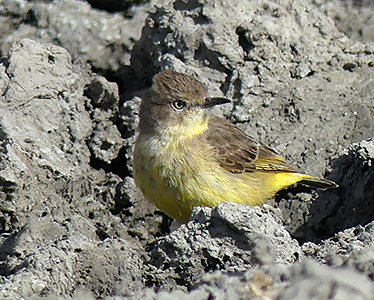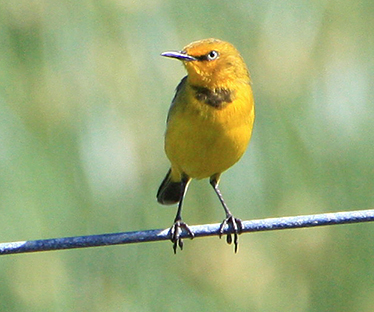Capricorn yellow chat


Common name: Capricorn yellow chat, yellow chat (Dawson)
Species name: Epthianura crocea macgregori
Family: Meliphagidae
Status: Endangered under the Queensland Nature Conservation Act 1992 and Critically Endangered under the Commonwealth Environmental Protection and Biodiversity Conservation Act 1999
The Capricorn yellow chat is a small bird weighing around 10g. Breeding males have a bright yellow crown, olive back, yellow rump and 4-6mm black bar across their chest. Non-breeding males are duller with the breast bar being less defined. Breeding females have a yellow crown, grading to an olive back and golden rump and vent. Non-breeding females are generally paler with a white throat and chin.
The Capricorn yellow chat is endemic to the Capricorn Coast in central Queensland. It occurs on the traditional country of the Darumbal People and the Bailai, Gurang, Gooreng Gooreng and Taribelang Bunda People. It was first collected by western science in the Rockhampton region in 1859 but then thought to be extinct until a small population was discovered on Curtis Island National Park in 1991. Two further populations have been found – on private land in the Broad Sound region (140km north of Curtis Island) in 2003 and the Fitzroy River delta (40km west of Curtis Island) in 2004.
Threats and recovery actions
There is little or no habitat connectivity between the three populations. In 2018, the total population size was estimated to be 220-280 birds. However, populations fluctuate significantly following breeding events. As the three populations are small and isolated, they are vulnerable to local extinction. Research is underway to determine genetic diversity within and between the subpopulations.
The Capricorn yellow chat lives in marine plains that receive significant freshwater flows during the wet season (December-February). Most of its habitat is below or just above sea level which makes it particularly vulnerable to sea level rise.
Threats to the Capricorn yellow chat include:
- Changes to hydrological regimes, such as dams and ponded pastures, and construction activities which impede freshwater flows.
- Feral pigs which uproot sedges and grasslands that the birds use for foraging and breeding, disturb nests and take eggs.
- The introduction of pasture grasses, para grass in particular, which can smother their habitat and displace the birds.
- High intensity grazing which reduces available habitat.
- Climate change impacts such as sea level rise, drought, heat waves, floods, wildfire, cyclones and storm surges.
- Other predators such as feral cats, foxes and wild dogs.


The Capricorn Yellow Chat Recovery Action Plan 2023-2033 identifies actions to address the key threats and support species recovery. It builds on the Capricorn yellow chat species summary and future directions report .
A Capricorn yellow chat working group was established in March 2021 to coordinate key stakeholders involved in research, recovery and management of the species. Recovery actions include:
- Population monitoring by Birdlife Capricornia and Central Queensland University with support from the Fitzroy Basin Association and the Queensland Parks and Wildlife Service.
- Greening Australia produced a detailed report on the feasibility of maintaining habitat for the Capricorn yellow chat and to mitigate the impacts of climate change, specifically looking at sea level rise.
- The Fitzroy Basin Association supports landowners to undertake feral pig control and the Queensland Parks and Wildlife Service controls feral pigs and other exotic herbivores located in Curtis Island National Park.
- Local landowners and managers are managing stock and grazing intensity supported by a Capricorn yellow chat habitat guide which was produced by Greening Australia. They are also actively managing pasture grasses including reducing the abundance of para grass.
- Weed management including work by the Gidarjil Land and Sea Rangers on Curtis Island National Park.
- Any proposed development on the marine plains is assessed to determine whether it will impact the species’ habitat and whether those impacts can be avoided or mitigated.
- Industries that use the marine plains are engaged in programs to protect Capricorn yellow chat habitat.
For more information about the Capricorn yellow chat, view the species profile.
Learn more about how you can help the Capricorn yellow chat and other Australian wildlife by supporting threatened species projects and caring for our native plants and animals.


